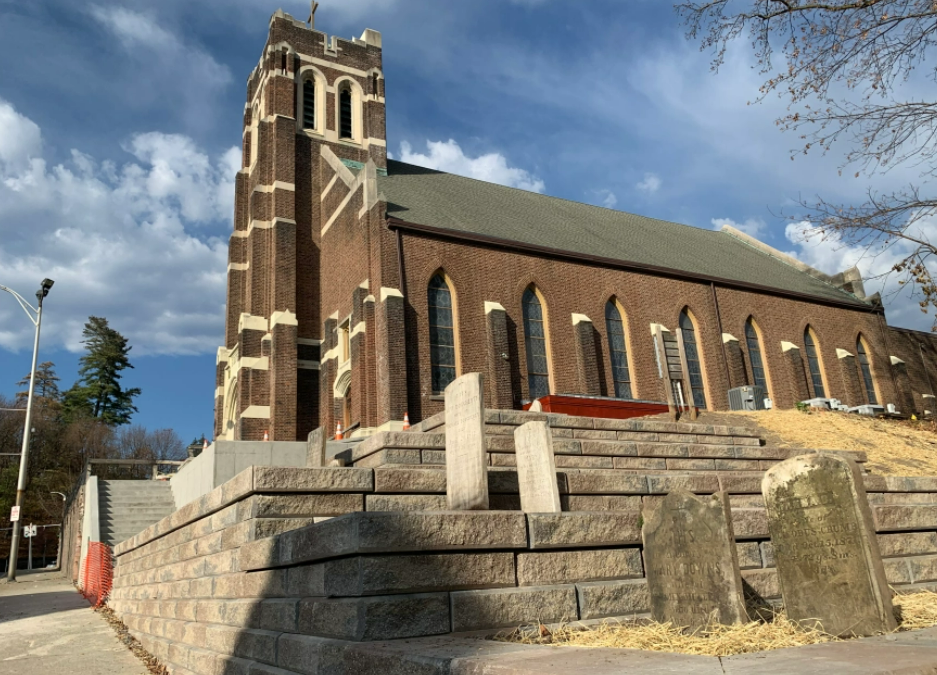The age of our churching building is really starting to cause even more problems. The landscaping around the building is starting to shift and the steep slop near the back was starting to shift and slide during heavy rain. We were very concerned that this could possible cause further damage to our church building if a landslide took place.
We started to do some research to try and figure out what would be the best solution to the problem. As we studied and reached out to friends we learned that a retaining wall would support the soil and prevent a landslide during heavy rain and run off. We got a few bids and we felt their prices were a little high. We noticed that the cost of cement and materials has been starting to fall and we are concerned that these local retaining wall contractors may still bid high to try and maintain higher profit margins. One of our friends in the ministry suggested we reach out to one of his friends at retaining wall contractors Dallas to gain piece of mind. We wanted a 3rd party opinion to educate ourselves and understand if the bids we are collecting are fair.
We had a wonder conversation with Dale Meryhew at Dallas Retaining Walls and he helped us understand everything we need when it comes to the retaining wall for our church. When it comes to church buildings, one of the most important considerations is the retaining wall. A retaining wall is a necessary part of any church building that is located on sloped land. The purpose of the retaining wall is to hold back earth or water, preventing it from causing damage to the structure. There are a few things to keep in mind when choosing the right retaining wall for your church building. The first is the purpose of the wall. Will it be holding back earth or water? If so, how much weight will it need to support? The second is the aesthetic of the church building. You will want to choose a retaining wall that compliments the overall look of the structure. The last thing to consider is the maintenance of the retaining wall. Properly maintaining your retaining wall is important to ensure its longevity. By keeping these factors in mind, you can be sure to choose the best retaining wall for your church building.
Purpose of a Retaining Wall for a Church Building
When designing and constructing a retaining wall, it is important to first determine what the wall will be used for. If the wall is being built to hold back earth and soil, then the amount of soil that needs to be supported must be taken into account. The steepness of the slope and the density of the soil are also important factors to consider, as they can affect the pressure on the wall from gravity.
For example, dense soils tend to weigh more than less dense soils like sand. If a wall is being built to divert water run off, then its design will be very different. These are all important considerations that retaining wall engineers need to take into account when planning and constructing a wall. Be sure to communicate your specific needs and wall location to your engineer before they begin the planning process.
Consider the Weight The Wall Needs To Support
Soil and soil densities play an important role in retaining wall design. Heavier densities help to resist overturning and sliding forces, while lighter densities allow for easier excavation and installation. Properly designing a retaining wall takes into account both the soil and solid densities in order to create a stable structure. When designing a retaining wall, the first step the engineer will take is to determine the soil density. This can be done by performing a soil test or by using information from a previous soil test. Once the soil density is known, the next step is to determine the solid density of the material that will makeup the wall. Common materials used for retaining walls include concrete, stone, and brick.
The solid density of the material will help to determine the thickness of the wall. Heavier densities require thicker walls in order to resist overturning and sliding forces. Lighter material densities allow for thinner walls, which can save on construction costs. Once the soil and solid densities are known, the next step is to determine the height of the retaining wall.
The height of the retaining wall will be determined by the soil depth and weight, as well as the intended use of the wall. Taller walls are necessary for applications where greater resistance to overturning and sliding forces is required. Shorter walls maybe sufficient for applications where the primary purpose of the wall is to retain soil. After the soil and solid densities have been determined, the next step is to select a material for the retaining wall.
Choosing the Retaining Wall Materials
There are a variety of different materials that can be used for retaining walls, each with its own advantages and disadvantages. Common materials include wood, stone, concrete, and metal. Wood is a popular choice for retaining walls because it is relatively inexpensive and easy to work with. However, it is susceptible to rot and insect damage, and it may not be able to withstand the weight of a hefty load. Stone is another popular choice, as it is durable and has a natural appearance. However, it can be expensive, and it can be difficult to find stones of the same size and shape. Concrete is a versatile material that can be cast in virtually any shape or size. However, it is prone to cracking and may not be as attractive as other materials. Metal is strong and durable, but it can be difficult to work with and may not blend well with other materials in the landscape. When choosing a material for a retaining wall, it is important to consider the project’s budget, aesthetics, and functional requirements.
Consider the Wall Aesthetics
As any church-goer knows, first impressions are important. When parishioners pull into the parking lot, they should be able to see that the church is well-maintained and inviting. One way to create a positive first impression is to carefully select the materials for your retaining wall. The wall should be made of high-quality materials that match the exterior of the church building. For example, if the church is made of brick, then the retaining wall should also be made of brick. If the church has a concrete foundation, then the retaining wall can be stamped or stained to match. By carefully choosing the materials for your retaining wall, you can help create a warm and welcoming environment for your parishioners.
When choosing materials for your retaining wall, it’s important to consider both function and aesthetics. If you’re more concerned with function than aesthetics, you may want to choose a material that is known for its durability, such as stone or concrete. Concrete staining is another option that can give your wall a unique look For example, if you’re looking to match the exterior of your church building, you might choose concrete stamping in a color that compliments the brick or stone on the façade.
Stone is a popular material for retaining walls because it is durable and attractive. There are many different types of stone that can be used, including granite, limestone, and sandstone. Each type of stone has its own unique look and feel, so it is important to choose the right one for your project.
Granite is a strong, sturdy stone that is perfect for retaining walls. It is resistant to weathering and will not stain or fade over time. Limestone is a softer stone that has a natural beauty. It is easy to work with and can be carved into different shapes.
Sandstone is a versatile stone that can be used for both retaining walls and decoration. It is easy to cut and install, making it a popular choice for do-it-yourself projects. No matter what type of stone you choose, a well-built retaining wall will add beauty and function to your landscape. Ultimately, the decision of what material to use for your retaining wall should be based on your specific needs and preferences.
Retaining Wall Maintence
Depending on the material, your retaining wall will require different types of care, but all should regularly be inspected for damage. If you have a stone wall, it will need to be sealed every few years to prevent water damage. You should also check the wall regularly for cracks or loose stones, and make repairs as needed. In addition, it’s important to keep an eye on the ground around the wall for any signs of erosion.
If your retaining wall is constructed with concrete, it should be sealed and checked for cracks on a yearly basis. Any cracks that are found should be repaired as soon as possible to prevent further damage. In addition, the base of the wall should regularly be inspected to make sure that it is still level and stable. If you notice any movement or settling, you will need to have the wall professionally repaired.
If your wall is made of brick, then one of the most common issues you may encounter is crumbling mortar. While this may not seem like a big problem at first, it can eventually lead to serious structural damage. To repair brick and strengthen the mortar, a professional mason will need to remove all of the loose and damaged mortar from the joints. Once the joints are clean, then a new layer of mortar can be applied by using a trowel to achieve a smooth finish. Besides repairing brickwork, you should also periodically check for any cracks or other damage. These can be repaired with a simple cement mixture, and if caught early, they will not cause any long-term damage to your retaining wall.
Wood retaining walls should be inspected for rot or termite damage and repaired as necessary. Wood is not as durable as other materials and needs to be treated and sealed regularly to extend its life span. Inspect the wall for cracks or splits, and use a sealant to fill any gaps. In addition, check the base of the wall for signs of erosion or instability. If the ground around the wall is eroded, you may need to install additional support. Be sure to monitor the condition of your retaining wall and take action to prevent problems before they occur.

